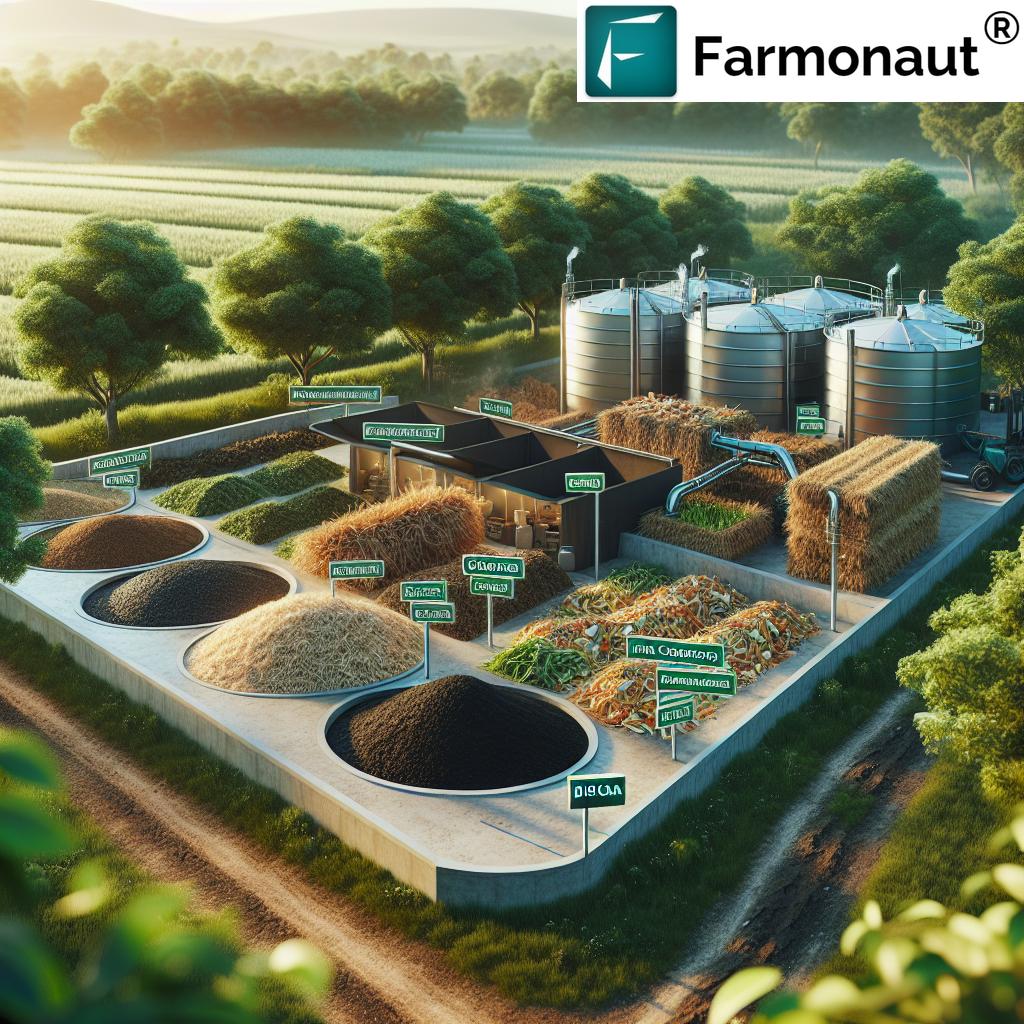Sustainable Outwintering: Maximizing Livestock Health and Farm Profitability with Smart Grazing Techniques
“Outwintering can reduce feed costs by up to 50% compared to traditional indoor housing methods.”
In the ever-evolving landscape of sustainable livestock management, outwintering has emerged as a game-changing practice for farmers seeking to enhance profitability and animal welfare. At Farmonaut, we’re committed to supporting innovative agricultural techniques that promote efficiency and environmental stewardship. In this comprehensive guide, we’ll explore the multifaceted benefits of outwintering, its challenges, and how modern technology is revolutionizing this age-old practice.

Understanding Outwintering: A Sustainable Approach to Livestock Management
Outwintering, the practice of keeping livestock outdoors during the winter months, is gaining traction among forward-thinking farmers. This approach to winter grazing techniques offers a myriad of benefits, from reducing feed costs to improving soil health in agriculture. Let’s delve into why outwintering is becoming an essential strategy for sustainable livestock management.
The Economic Advantages of Outwintering
- Reduced Feed Costs: By allowing animals to graze on pasture or forage crops throughout winter, farmers can significantly cut down on expensive stored feed.
- Lower Labor Requirements: Outwintering often requires less daily labor compared to indoor housing systems, freeing up time and resources for other farm activities.
- Decreased Infrastructure Needs: With animals kept outdoors, there’s less need for extensive indoor housing facilities, reducing capital investment and maintenance costs.
These economic benefits make outwintering an attractive option for farmers looking to optimize their operations and improve their bottom line.
Environmental Benefits and Soil Health
Outwintering isn’t just good for the farm’s finances; it’s also beneficial for the environment:
- Improved Soil Structure: The movement of animals across the land helps to aerate the soil and distribute nutrients more evenly.
- Enhanced Nutrient Cycling: Manure deposited directly on the fields contributes to natural fertilization, reducing the need for synthetic inputs.
- Increased Biodiversity: Pastures used for outwintering can support a wider range of plant and animal species compared to intensively managed indoor systems.
By implementing outwintering strategies, we’re not just thinking about immediate farm profitability but also long-term environmental sustainability.
Outwintering Benefits for Farmers: A Closer Look
The advantages of outwintering extend beyond mere cost savings. Let’s examine how this practice can transform various aspects of farm management:
1. Enhanced Animal Welfare
Contrary to common belief, many livestock species can thrive in outdoor winter conditions when properly managed:
- Natural Behavior: Outwintering allows animals to express natural behaviors more freely than in confined spaces.
- Improved Health: Fresh air and exercise can lead to better respiratory health and stronger immune systems.
- Reduced Stress: Less crowding and a more natural environment can decrease stress levels in animals.
2. Pasture Management and Soil Improvement
Outwintering can be a powerful tool for pasture management:
- Extended Grazing Season: By utilizing winter-hardy forage crops, farmers can extend the grazing season and reduce reliance on stored feed.
- Soil Organic Matter: Animal traffic and manure deposition increase organic matter in the soil, improving its structure and fertility.
- Weed Control: Strategic grazing can help control weeds, reducing the need for herbicides.
These benefits contribute to a more sustainable and resilient farming system.
3. Efficient Farm Labor Practices
Outwintering can streamline farm operations:
- Reduced Daily Chores: Less time spent on indoor feeding and cleaning tasks.
- Simplified Manure Management: With animals depositing manure directly on fields, there’s less need for manure collection and spreading.
- Flexible Work Schedule: Outwintering allows for more flexible farm management, as daily routines are less rigid than with indoor systems.
By optimizing labor efficiency, farmers can focus on other aspects of farm management and potentially diversify their operations.

Implementing Successful Outwintering Strategies
While the benefits of outwintering are clear, successful implementation requires careful planning and management. Here are key strategies to ensure a successful outwintering program:
1. Selecting Suitable Land and Animals
- Land Assessment: Choose well-drained areas with natural shelter if possible. Avoid steep slopes or areas prone to waterlogging.
- Animal Selection: Not all animals are suitable for outwintering. Consider breed, age, and condition when selecting livestock for outdoor winter grazing.
2. Forage Planning and Management
- Crop Selection: Plant winter-hardy forage crops like kale, swedes, or fodder beet to provide nutritious feed throughout the winter.
- Grazing Rotation: Implement a rotational grazing system to ensure efficient use of forage and prevent overgrazing.
- Supplementary Feeding: Be prepared to provide additional feed during harsh weather or when forage quality declines.
3. Shelter and Infrastructure
- Natural Windbreaks: Utilize hedgerows, trees, or natural landforms to provide shelter from wind and rain.
- Artificial Shelters: Consider portable shelters or windbreaks that can be moved to prevent excessive soil damage in one area.
- Water Access: Ensure a reliable, unfrozen water supply throughout the winter months.
4. Health Monitoring and Management
- Regular Health Checks: Implement a routine for checking animals’ condition and health status.
- Parasite Control: Develop a parasite management plan suitable for outwintered livestock.
- Nutritional Supplements: Provide mineral licks or supplements to address potential deficiencies in winter forage.
By carefully considering these factors, farmers can maximize the benefits of outwintering while minimizing potential risks.
“Cattle outwintered on pasture can experience up to 30% fewer lameness issues than those kept indoors.”
Leveraging Technology for Successful Outwintering
In the modern era of precision agriculture, technology plays a crucial role in enhancing the efficiency and effectiveness of outwintering practices. At Farmonaut, we’re at the forefront of providing innovative solutions to support sustainable livestock management.
Satellite-Based Pasture Monitoring
Our advanced satellite imagery technology allows farmers to:
- Track Pasture Health: Monitor vegetation indices to assess forage availability and quality.
- Identify Overgrazing: Detect areas of potential overgrazing or soil compaction early.
- Plan Rotations: Use real-time data to optimize grazing rotations and rest periods.
By leveraging these insights, farmers can make data-driven decisions to maximize pasture utilization while preserving soil health.
Weather Monitoring and Forecasting
Our platform integrates accurate weather forecasting, crucial for outwintering success:
- Severe Weather Alerts: Receive timely warnings about approaching storms or extreme cold.
- Precipitation Tracking: Monitor rainfall and snowfall to manage soil moisture and prevent waterlogging.
- Temperature Trends: Use temperature data to adjust feeding strategies and shelter provisions.
This weather intelligence helps farmers prepare and respond proactively to changing conditions, ensuring animal welfare and environmental protection.
Livestock Tracking and Monitoring
While Farmonaut doesn’t directly provide livestock tracking devices, our platform can integrate with various IoT sensors and trackers to:
- Monitor Animal Movement: Track grazing patterns and identify areas of overuse or underuse.
- Health Monitoring: Integrate with health monitoring systems to detect potential issues early.
- Fencing Management: Work with virtual fencing technologies for flexible pasture management.
These technologies enhance the precision and efficiency of outwintering practices, allowing for more nuanced management strategies.
Overcoming Challenges in Outwintering
While outwintering offers numerous benefits, it’s not without its challenges. Understanding and addressing these issues is crucial for successful implementation:
1. Soil Management
Challenge: Potential soil damage and compaction, especially in wet conditions.
Solutions:
- Implement rotational grazing to distribute animal impact.
- Use portable feed and water stations to prevent excessive trampling in one area.
- Consider sacrificial paddocks for extreme weather conditions.
2. Nutritional Management
Challenge: Ensuring adequate nutrition as forage quality declines in winter.
Solutions:
- Plan for strategic supplementary feeding.
- Use body condition scoring to monitor animal health and adjust feed accordingly.
- Consider planting diverse forage mixtures to extend the grazing season.
3. Animal Welfare in Extreme Weather
Challenge: Protecting animals from harsh winter conditions.
Solutions:
- Provide adequate natural or artificial shelter.
- Ensure constant access to fresh, unfrozen water.
- Develop an emergency plan for extreme weather events.
4. Regulatory Compliance
Challenge: Meeting environmental and animal welfare regulations.
Solutions:
- Stay informed about local and national regulations regarding outwintering.
- Implement best practices for soil and water protection.
- Maintain thorough records of animal health and management practices.
By anticipating and addressing these challenges, farmers can successfully implement outwintering strategies that benefit their animals, their land, and their bottom line.
Case Studies: Successful Outwintering in Practice
While we don’t have specific case studies to share, numerous farmers across various regions have successfully implemented outwintering strategies. Common themes in successful outwintering include:
- Gradual Implementation: Starting with a small portion of the herd and expanding over time.
- Adaptive Management: Flexibility in responding to weather conditions and animal needs.
- Continuous Learning: Embracing new technologies and techniques to improve practices year over year.
- Community Engagement: Sharing experiences and learning from other farmers practicing outwintering.
These success stories demonstrate that with proper planning and management, outwintering can be a viable and beneficial strategy for many livestock operations.
The Future of Outwintering: Trends and Innovations
As we look to the future, several trends and innovations are shaping the practice of outwintering:
1. Climate-Resilient Forage Crops
Research into developing more resilient and nutritious winter forage varieties will expand outwintering possibilities in diverse climates.
2. Precision Livestock Farming
Advancements in wearable technology for livestock will provide even more detailed insights into animal behavior and health during outwintering.
3. Integrated Agroforestry Systems
Combining outwintering with agroforestry practices can create more diverse and resilient farming ecosystems.
4. Carbon Sequestration Potential
Increasing focus on the carbon sequestration potential of well-managed grazing systems may provide additional incentives for outwintering practices.
At Farmonaut, we’re committed to staying at the forefront of these developments, continuously enhancing our platform to support innovative and sustainable farming practices like outwintering.
Conclusion: Embracing Outwintering for a Sustainable Future
Outwintering represents a significant opportunity for farmers to enhance profitability, improve animal welfare, and contribute to environmental sustainability. By carefully implementing outwintering strategies and leveraging modern agricultural technology, farmers can overcome challenges and reap the numerous benefits of this practice.
As we continue to face global challenges in agriculture, including climate change and resource constraints, innovative approaches like outwintering will play an increasingly important role. At Farmonaut, we’re dedicated to supporting farmers in this journey towards more sustainable and efficient livestock management.
Whether you’re considering outwintering for the first time or looking to optimize your existing practices, our advanced satellite-based farm management solutions are here to help. By providing real-time insights into pasture health, weather conditions, and more, we empower farmers to make informed decisions that benefit their animals, their land, and their bottom line.
Embrace the future of sustainable livestock management with outwintering, and let Farmonaut be your partner in this exciting journey towards a more resilient and profitable farming future.
Comparison: Traditional Winter Feeding vs. Outwintering
| Aspect | Traditional Winter Feeding | Outwintering |
|---|---|---|
| Cost Efficiency | High feed costs | Reduced feed costs by 30-40% |
| Labor Requirements | High daily labor for feeding and cleaning | Reduced labor needs, more flexible schedule |
| Animal Health | Potential for increased respiratory issues | Improved overall health, fewer lameness issues |
| Soil Impact | Minimal direct impact | Improved soil structure and fertility |
| Environmental Sustainability | Higher carbon footprint due to feed production and transportation | Lower carbon footprint, improved nutrient cycling |
FAQs About Outwintering
- Q: Is outwintering suitable for all types of livestock?
A: While many livestock can be outwintered, it’s particularly common for cattle and sheep. The suitability depends on factors like breed, age, and condition of the animals. - Q: How does outwintering affect soil health?
A: When managed properly, outwintering can improve soil health by increasing organic matter content and enhancing soil structure through animal movement and manure deposition. - Q: What are the main challenges of outwintering?
A: Key challenges include managing soil damage in wet conditions, ensuring adequate nutrition, protecting animals from extreme weather, and complying with environmental regulations. - Q: How can technology help in outwintering management?
A: Technologies like satellite imagery for pasture monitoring, weather forecasting systems, and livestock tracking devices can greatly enhance the efficiency and effectiveness of outwintering practices. - Q: Does outwintering work in all climates?
A: While outwintering can be adapted to many climates, it’s most successful in areas with moderate winters. Extreme cold or consistently wet conditions can pose significant challenges.
For more information on how Farmonaut can support your outwintering strategies, visit our website or download our app:
For developers interested in integrating our satellite and weather data into their own systems, check out our API and API Developer Docs.
Farmonaut Subscriptions
















